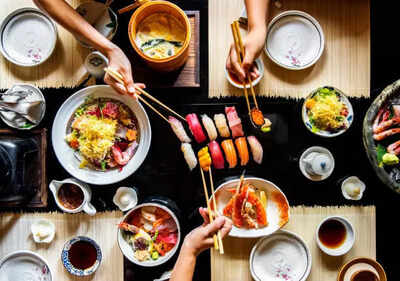ARTICLE AD BOX

Walk through any metro city today and you’ll notice something new on the dining scene. Sushi rolls are winding their way into delivery menus, ramen bowls are warming up rainy evenings, and cafes are serving matcha desserts alongside cappuccinos.
Just ten years ago, Japanese cuisine in India was limited to luxury hotels and a handful of niche restaurants. Today, it has moved out of its exclusive corners and into everyday conversations, cravings and cravings.What’s driving this shift? It’s a fascinating mix of culture, curiosity, and the search for healthier food.Sushi was just the beginning

Back in the early 2000s, eating sushi in India was considered adventurous, even risky. Most people thought raw fish and soy sauce were too alien to the Indian palate.
Fast forward to today and sushi delivery is as casual as ordering pizza. Add to that the rise of ramen restaurants, tempura counters and even Japanese-inspired bakeries, and you can see how the cuisine has found its place in urban India.Adwait Anantwar, Chef Partner at INJA, puts it perfectly. He says, "Japanese food has become the new Chinese in India because pop culture has made it hard to miss. Anime, cosplay, Instagram reels, travel and even the craze for matcha have pulled people in because everyone wants a taste of what they have been watching.
I see it as the perfect storm of curiosity and flavour. Japanese food feels trendy yet soulful, with clean and umami-rich flavour profiles that surprise the palate, and once someone tries a hot bowl of Tonkotsu or Miso Ramen, or the crisp prawn tempura, or a Salmon Nigiri sushi roll, there’s really no turning back."In many ways, food has become an extension of lifestyle and entertainment. People don’t just want to watch Japan on a screen anymore, they want to taste it.Why Indian diners are falling in love with Japanese food

The trend is not just about novelty. More and more Indians are seeking meals that are fresh, light, and nourishing. And Japanese food fits almost magically into this mindset. Its philosophy is to highlight fresh ingredients, use minimal oil, and balance dishes with rice, protein, vegetables and fermented foods that help digestion.Chef Saurabh Sharan, Head Chef at Guppy, explains, "Japanese cuisine has gained immense popularity worldwide due to its subtle flavours, elegant presentation, unique composition, and perceived health benefits. It also has the remarkable ability to incorporate ingredients from across the globe, making it highly adaptable to local produce and culinary traditions. Historically, Japan remained relatively secluded from the rest of the world. However, with the opening of trade and the impact of globalisation, Japanese cuisine, along with its key ingredients has travelled exceptionally well and has been widely embraced by international consumers."In India, this adaptability is evident everywhere. In Gurgaon you can find avocado and crispy vegetable sushi rolls for vegetarians. In Bangalore, ramen bowls are sometimes given a South Indian twist. Some chefs have even drawn inspiration from Indian-style gravies for Japanese curry udon.Everyday stories of discovery

Ask around, and you’ll hear charming little stories of how Japanese food is making its way into daily life. A young couple in Delhi who first tried sushi because of an anime episode now swear by it every weekend.
A professional in Bangalore who spent two years in Tokyo came back and introduced her parents to ramen. In Ahmedabad and Pune, families are exploring tempura platters during outings instead of sticking to familiar pizzas and pastas.It isn’t just about dining out either. Delivery apps are full of bento box options and do-it-yourself sushi kits. College students, office workers, and even older food lovers are experimenting at home, making Japanese food feel less intimidating and more accessible.A new chapter in India’s food storyIndia has always welcomed outside food cultures. Mughlai cuisine came with the Mughals, bakery culture with the British, and Indo-Chinese became an emotion of its own. Japanese food is simply the latest chapter, but it comes with its own unique appeal. For an increasingly health-conscious generation, the timing couldn’t be better. Indians grappling with lifestyle issues like obesity, diabetes, and high cholesterol are seeking alternatives that are nutritious but don’t compromise on taste.
Japanese cuisine, with its omega-3 rich fish, antioxidant-rich seaweed, and probiotic-packed miso and pickles, offers exactly that balance.A Delhi-based nutritionist Mansi recently put it nicely after suggesting sushi over butter chicken. “It feels like travelling without leaving your plate-light, refreshing, and healthy.”Where it’s going nextIndustry reports say Japanese dining in India has been growing by nearly 15 to 20 percent every year since 2019, and not just in metros like Delhi or Mumbai.
Tier-2 cities are catching on quickly, with restaurants opening in places like Jaipur and Lucknow. Delivery models are accelerating growth even more, as people experiment with sushi and ramen in the comfort of their homes. There are challenges of course. Many ingredients are still imported and expensive, and awareness of certain dishes is limited in smaller cities.
But the momentum is strong, and the direction is clear. As Adwait Anantwar says, once people have that first sip of ramen broth or bite of sushi rice, there is really no going back.The rise of Japanese cuisine in India isn’t just about food. It’s about curiosity, global culture, and the way Indians are looking for lighter and fresher dining experiences. Much like Indo-Chinese became a staple decades ago, sushi, ramen and matcha are now weaving themselves into the everyday Indian food story. And standing in a busy food court today, it isn’t hard to notice-sometimes the queue for sushi is just as long, if not longer, than the one for noodles.



.png)
.png)
.png)
















 3 hours ago
3
3 hours ago
3








 English (US) ·
English (US) ·